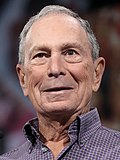Top Qs
Timeline
Chat
Perspective
2020 Florida Democratic presidential primary
From Wikipedia, the free encyclopedia
Remove ads
The 2020 Florida Democratic presidential primary took place on March 17, 2020, the third primary Tuesday of the month, as one of three states voting on the same day in the Democratic Party primaries for the 2020 presidential election, while the contest in Ohio had been postponed for roughly a month. The Florida primary was a closed primary, with the state awarding the fourth-largest amount of delegates towards the 2020 Democratic National Convention and the third-largest amount up to that point: 249 delegates, of which 219 were pledged delegates allocated on the basis of the results of the primary.
Former vice president Joe Biden was the clear winner of the Florida primary, receiving almost 62% of the vote and 162 delegates, winning every county in the state and significantly extending his delegate lead.[1] Senator Bernie Sanders placed second with only around 23% of the vote and 57 delegates, while former mayor Michael Bloomberg, who had already withdrawn, still got 8% of the vote.
Remove ads
Procedure
Summarize
Perspective
Florida was one of three states which held primaries on March 17, 2020, alongside Arizona and Illinois,[2] while only one day before Ohio had been the first state to postpone its primary due to the COVID-19 pandemic and cancel in-person voting, accepting ballots until April 28 instead.
Voting took place throughout the state from 7:00 a.m. until 7:00 p.m. local time. In the closed primary, candidates had to meet a threshold of 15 percent at the congressional district or statewide level in order to be considered viable. The 219 pledged delegates to the 2020 Democratic National Convention were allocated proportionally on the basis of the results of the primary. Of these, between three and seven were allocated to each of the state's 27 congressional districts and another 29 were allocated to party leaders and elected officials (PLEO delegates), in addition to 47 at-large delegates.[3] As a March primary on Stage I of the primary timetable Florida received no bonus delegates, in order to disperse the primaries between more different date clusters and keep too many states from hoarding on a March date.[4]
Post-primary congressional district caucuses convened on May 2, 2020, to designate national convention district delegates. The state convention was subsequently held on May 30, 2020, to vote on the 47 at-large and 29 pledged PLEO delegates for the Democratic National Convention. The delegation also included 30 unpledged PLEO delegates: 16 members of the Democratic National Committee, 13 representatives from Congress (including former DNC chair Debbie Wasserman Schultz), and former DNC chair Kenneth M. Curtis.[3]
Remove ads
Candidates
The following candidates qualified for the ballot in Florida:[5]
Running
Withdrawn
Steve Bullock and Kamala Harris withdrew so that they did not appear on the ballot.[6]
Remove ads
Polling
Remove ads
Results
Summarize
Perspective

Biden—40–50%
Biden—50–60%
Biden—60–70%
Biden—70–80%
Biden—80–90%
Results by county
Remove ads
Notes
Summarize
Perspective
Additional candidates
- Bloomberg withdrew on March 4, 2020, 13 days before the primary. At that time, in a few counties early voting had begun.
- Candidate withdrew after Super Tuesday when early voting had begun in a few counties.
- Calculated by taking the difference of 100% and all other candidates combined
- FiveThirtyEight aggregates polls with a trendline regression of polls rather than a strict average of recent polls.
- Key:
A – all adults
RV – registered voters
LV – likely voters
V – unclear - Gabbard with 2%; "Other" with 10%
- Gabbard with 2%; "Other" with 2%
- In a two-person race
- Gabbard with 1%; Steyer with 0%
- Gabbard with 2%
- Not yet released
- Gabbard with 2%; "Other" with 6%
- Gabbard with 1%; Yang with <1%
- Steyer with 0%
- Gabbard and Steyer with 1%
- Gabbard with 3%
- Steyer with 0%
- Steyer with 1%
- Gabbard with 2%; Steyer with 1%; "None of these" with 1%
- Gabbard and Steyer with 0%; "Other" with 1%
- Steyer with 2%
- Steyer with 2%; Gabbard, Bennet, and Yang with 1%
- Steyer with 1%
- Steyer with 2%
- If only Biden, Sanders and Warren remained as candidates
- Steyer with 2%
- Steyer with 2%; Bennet, Delaney, and Gabbard 1%; Patrick with 0%
- Listed as "someone else/unsure"
- Gabbard with 1%; others with 0%
- Listed as others
- Messam with 3%; Bennet, de Blasio, Bullock, Gabbard and Ryan with 1%; Castro, Delaney, Sestak, Steyer and Williamson with 0%
- Castro and Messam with 1%; Bennet, Delaney, Gabbard, Gillibrand, Gravel, Hickenlooper, Moulton, Ryan, and Williamson with 0%
- Bennet, Bullock, Castro, de Blasio, Delaney, Gabbard, Gillibrand, Gravel, Hickenlooper, Inslee, Messam, Moulton, Ryan, Swalwell, and Williamson with <1%; others with 1%
- Delaney with 2%; Bennet, de Blasio, Hickenlooper, Inslee, Ryan, and Swalwell with 1%; Bullock, Castro, Gabbard, Gillibrand, Gravel, Messam, Moulton, and Williamson with 0%
- Gabbard and Gillibrand with 2%; Castro, and Inslee with 1%; Delaney and Hickenlooper with 0%
- Castro with 2%; Gillibrand, Gravel, and Moulton with 1%; Delaney, Gabbard, Hickenlooper, Inslee, Messam, Ryan, Swalwell, and Williamson with 0%; others with 9%
- Brown, Castro, Delaney, Gillibrand, Gabbard, Hickenlooper, and Inslee with 0%
- Winfrey with 17%; Holder with 5%; Brown with 3%; Cuomo, Gillibrand, and Murphy with 2%; Bullock, Landrieu, Patrick, and McAuliffe with 1%; others with 2%
Remove ads
See also
References
External links
Wikiwand - on
Seamless Wikipedia browsing. On steroids.
Remove ads




